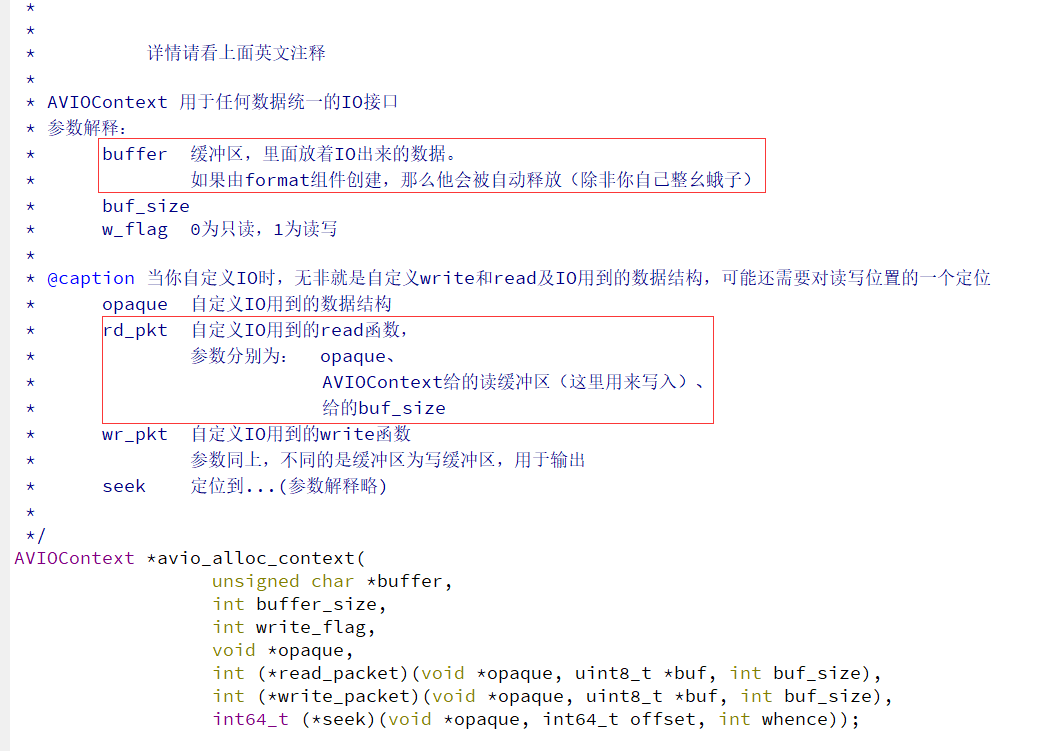手把手FFmpeg入门——音频解码+仿流媒体
http://www.ffmpeg.org/doxygen/4.0/decode_video_8c-example.html
http://www.ffmpeg.org/doxygen/4.0/avio_reading_8c-example.html
官方例子链接,我的是由上面改编的
运行环境:
win QT64位
程序目的:
用流的方式解析音频
基础知识:
基本原理:
1. 为了把文件当流读取,需要自定义IO函数,无非就是read、write、读写的数据结构、再多就是流定位seek了
这个在ffmpeg里在构造AVIOContext时设置,如下图是说明

2. 几乎所有的解码都分这几个过程:
-->解协议-->解封装-->解码-->
在ffmpeg里由解码器(AVCodec)、解码器环境(AVCodecContext)、音频操作环境(AVFormatContext)、包(AVPacket)、帧(AVFrame)这几个组件配合完成。
基本步驺:
1. 初始化变量,用的各个对象的工厂函数(FFmpeg库的基本规律)
2. 用操作环境链接文件、解码器,并尝试读包
3. 读包直到流结束,每读一个包就用解码器解码,然后就干你想干的任何事情了,嘿嘿嘿。(本例是封装为PCM格式输出到pcm文件,完了可以用audition打开)
4. 拆环境
不到100行的代码:
1 // 目的在于了解AVFormatContext的packet是怎么发送和接收的, 2 // 网络上的大同小异 3 #include <QDebug> 4 extern "C" { 5 #include <libavcodec/avcodec.h> 6 #include <libavformat/avformat.h> 7 #include <libavformat/avio.h> 8 #include <libavutil/file.h> 9 } 10 11 struct buffer_data { 12 uint8_t *ptr; 13 size_t size; ///< size left in the buffer 14 }; 15 16 static int read_packet(void *opaque, uint8_t *buf, int buf_size) 17 { 18 struct buffer_data *bd = (struct buffer_data *)opaque; 19 buf_size = FFMIN(buf_size, bd->size); 20 21 if (!buf_size) 22 return AVERROR_EOF; 23 printf("ptr:%p size:%u buf:%p, buf_size:%u\n", bd->ptr, bd->size, buf, buf_size); 24 25 /* copy internal buffer data to buf */ 26 memcpy(buf, bd->ptr, buf_size); 27 bd->ptr += buf_size; 28 bd->size -= buf_size; 29 30 return buf_size; 31 } 32 33 int main(int argc, char *argv[]) 34 { 35 AVFormatContext *fmt_ctx = NULL; 36 AVIOContext *avio_ctx = NULL; 37 uint8_t *buffer = NULL, *avio_ctx_buffer = NULL; 38 size_t buffer_size, avio_ctx_buffer_size = 4096; 39 char *input_filename = NULL; 40 struct buffer_data bd = { 0 }; 41 42 input_filename = "D:/test.mp3"; 43 44 /* slurp file content into buffer 建立文件到内存的映射 */ 45 av_file_map(input_filename, &buffer, &buffer_size, 0, NULL); 46 47 /* fill opaque structure used by the AVIOContext read callback 用AVIOContext的读回调函数填充黑盒 */ 48 bd.ptr = buffer; 49 bd.size = buffer_size; 50 51 fmt_ctx = avformat_alloc_context(); 52 avio_ctx_buffer = (uint8_t*)av_malloc(avio_ctx_buffer_size); 53 avio_ctx = avio_alloc_context(avio_ctx_buffer, avio_ctx_buffer_size, 54 0, &bd, &read_packet, NULL, NULL); 55 fmt_ctx->pb = avio_ctx; 56 57 avformat_open_input(&fmt_ctx, NULL, NULL, NULL); 58 avformat_find_stream_info(fmt_ctx, NULL); 59 av_dump_format(fmt_ctx, 0, input_filename, 0); 60 61 // 解码 62 AVCodec *codec = avcodec_find_decoder(AV_CODEC_ID_MP3); 63 AVCodecContext *codec_ctx = avcodec_alloc_context3(codec); 64 avcodec_open2(codec_ctx, codec, NULL); 65 FILE *fp = fopen("D:/dst.pcm", "wb+"); 66 int aidx; 67 for(int i = 0; i < fmt_ctx->nb_streams; ++i) 68 if(fmt_ctx->streams[i]->codec->codec_type == AVMEDIA_TYPE_AUDIO){ 69 aidx = i; 70 break; 71 } 72 73 AVPacket *pkt = av_packet_alloc(); 74 AVFrame *frame = av_frame_alloc(); 75 int framecount = 0; 76 int sample_size =av_get_bytes_per_sample(codec_ctx->sample_fmt); 77 while(av_read_frame(fmt_ctx, pkt) >= 0){ 78 if(pkt->stream_index == aidx){ 79 avcodec_decode_audio4(codec_ctx, frame, &framecount, pkt); 80 for(int n = 0; n < frame->nb_samples; ++n) 81 for(int ch = 0; ch < frame->channels; ++ch){ 82 fwrite(frame->data[ch] + sample_size*n, 1, sample_size, fp); 83 } 84 } 85 } 86 87 avformat_close_input(&fmt_ctx); 88 /* note: the internal buffer could have changed, and be != avio_ctx_buffer */ 89 if (avio_ctx) { 90 av_freep(&avio_ctx->buffer); 91 av_freep(&avio_ctx); 92 } 93 av_file_unmap(buffer, buffer_size); 94 95 return 0; 96 }
学习是一个循序渐进的过程,没有捷径,只有坚持和努力才是最快的方法!




